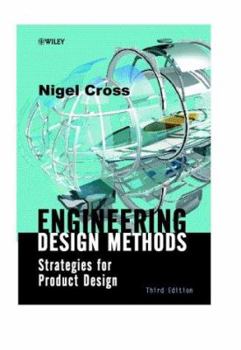Engineering Design Methods: Strategies for Product Design
Select Format
Select Condition 
Book Overview
Written in a clear and readable style by an experienced author of teaching texts, Engineering Design Methods is an integrated design textbook that presents specific methods within an overall strategy... This description may be from another edition of this product.
Format:Paperback
Language:English
ISBN:0471872504
ISBN13:9780471872504
Release Date:November 2000
Publisher:Wiley
Length:224 Pages
Weight:1.85 lbs.
Dimensions:0.5" x 6.6" x 9.6"
Customer Reviews
3 ratings
A useful book in order to give help in structuring and evaluating ideas,
Published by Thriftbooks.com User , 14 years ago
The author, Prof. Nigel Cross (The Open University,Milton Keynes, United Kingdom) offers by this book a strategic approach and a number of tactics as aids for designing successful products. It is intended primarly for use by students and teachers of engineering design and industrial design. Its main emphasis is on the design of products that have an engineering content, although most of the principles and approaches that it teaches are relevant to the design of all kinds of products. It is essentially concerned with the problem formulation and the conceptional and embodiment stages of design, rather than the detail design which is the concern of most engineering texts. This book can most effectively be used in conjunction with projects and exercises that require the exploration and clarificatioin of design problems and the generation and evaluation of design solutions. The author offers several interesting and useful methods that are structured in clear charts and diagrams that are easy to survey. Especially the evaluation methods are very interesting: According to my knowledge Nigel Cross ist the only author of a book of design who describes e.g. the Morphological Chart Method. Cross dos not present his methods in abstraction, but shows also the practical application by examples everybody can understand. Unfortunately, there are not many pictures or photos and colour is also a missing thing in this book. And the rare pictures you can find in this book seem to be a product of the period between 1970 and 1980, although this book was first published in 2000. Building on the world-wide success of the previous editions, this new edition reinforces its original three-part structure. It is devided in the following chapters or headlines: Part One: Understanding Design (1. The Nature of Design; 2. Design Ability; 3. The Design Process); Part Two: Doing Design (4. New Design Procedures; 5. Clarifying Objectives; 6. Establishing Functions; 7. Setting Requirements; 8. Determining Characteristics; 9. Generating Alternatives; 10. Evaluating Alternatives; 11. Improving Details) and Part Three: Managing Design (12. Design Strategies; 13. Product Development). In my opinion this book is not only very useful for students or lectures but also for practitioners. - Dipl.-Ing., Dipl.-GwL., StR. Christoph Erlemeier, Stuttgart, Germany -
Fast reference for product designers & design students
Published by Thriftbooks.com User , 15 years ago
Nigel Cross framed the world's dialogue about "design thinking" with his 2006 book Designerly Ways of Knowing. His updated edition of Engineering Design Methods is a wonderful quick reference of common product design methods, described by design phase. This is no easy task because designers are notorious about using themselves to prototype new processes and models, so any book will be challenged to document a general shared set of methods for the product design community. For those interested in learning more, another resource is Hugh Dubberly's How Do You Design?, which is still a work of progress years later.
fuzzy issues to be mastered
Published by Thriftbooks.com User , 18 years ago
If you are an engineering undergrad, this book will be fuzzier than most of your texts. It doesn't deal directly with the hard, quantitative issues like finding the load on suspension bridge, or laying out the control systems of a satellite. Instead, the book's subject is far more subjective. But no less essential. Product design is a skill you need to master, and the book tries to help you along. Of the methodologies discussed, you might find the objectives tree and the evaluation chart to be especially useful. These can help you narrow down the design choices.





